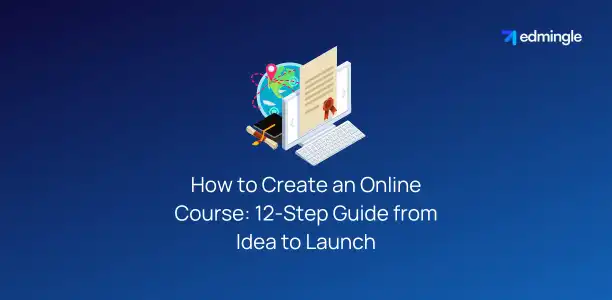
Are you an expert in your field? Do you want to share it with the world? If yes, just create an online course business.
But the bigger question is “how”. To answer that, in this blog, we’ll guide you on how to create an online course.
Whether you’re looking to upskill people. Or just want to have a source of passive income. This guide will help you do that like a breeze.
So buckle up.
Online Course
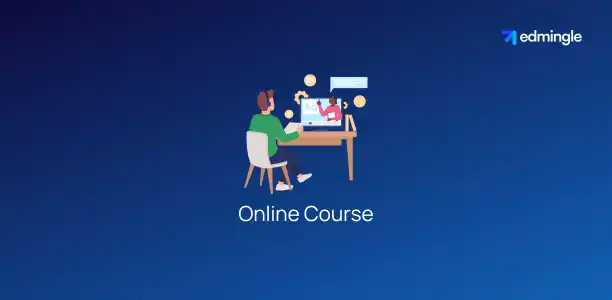
An online course refers to an educational program. One that is intentionally crafted for internet accessibility.
It provides learners with the opportunity to acquire knowledge. Furthermore, develop skills & engage in interactive activities, through online platforms.
They cover a wide range of subjects. From academic topics to practical skills and professional development.
These are structured similarly to traditional in-person classes. But are delivered in a virtual environment.
Thereby, allowing participants to access and complete from anywhere with an internet connection.
Also Read: Difference Between Course and Training.
6 Reasons Why to Create an Online Course?
Creating an online course offers a multitude of compelling reasons. And each resonates with educators, experts & entrepreneurs alike.
Here are 6 reasons why it could be a game-changer for you.
| 1.Share Your Expertise Globally | Have a passion or expertise you’re eager to share? An online course provides a platform. To impart your knowledge, skills, and insights to a global audience hungry for learning. |
| 2.Monetization Opportunities | Beyond sharing knowledge, profitable online courses can generate passive income. By pricing appropriately, you can create a steady revenue stream. |
| 3.Enhance Authority & Build a Legacy | Developing an online course establishes you as an authority in your field. This credibility can attract opportunities for speaking engagements, partnerships, and more. Your curricula becomes part of your digital legacy. Your knowledge lives on. Hence, continuing to impact learners long into the future. |
| 4.Cost-Effective Learning | Online courses eliminate travel and accommodation expenses. That are generally associated with in-person workshops. Learners can access top-notch education without leaving their homes. |
| 5.Flexible Income Streams | Besides one-time purchase options. You can create subscription models, membership sites, or bundles. To diversify your income sources. |
| 6.Scale Your Impact & Empower Others | Impact lives by enabling others to achieve their goals. Witnessing the transformation of your learners can be highly fulfilling. Since they can accommodate an infinite number of participants. You can easily scale your impact without compromising on quality. |
In short, creating an online course empowers you to share knowledge. All while building authority, generating passive income & shaping the educational landscape.
Once you’ve created one. You can use an LMS to sell it online. To know more on this, check our blog on Best LMS for Selling Courses.
6 Step Guide on How to Create an Online Course
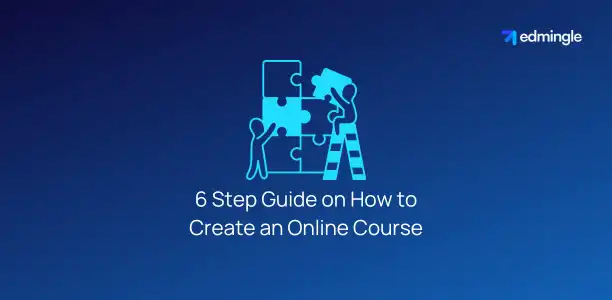
Now that we know the benefits of creating an online course. Let’s dive into the 6 steps towards creating & selling one.
Step 1.Find Your Niche
- Choose a topic: Select a subject that aligns with your expertise. And one that resonates with your target audience.
- Validate your idea: Research about the demand. And ensure your chosen topic has an eager audience.
- Research the topic extensively: Dive deep into your subject matter to provide valuable insights.
Step 2.Understand Your Audience
Understanding your target audience is key to tailoring your content. Create it according to their needs to ensure engagement & satisfaction.
Step 3.Define Clear Goals
Clarify what learners will achieve after completing your course. Achieve this by setting clear and achievable learning objectives.
Step 4.Plan Your Course Outline
Organize your content logically. Create a storyboard or outline that outlines each module and lesson. A strong lesson plan means a strong outcome.
Step 5.Choose the Platform to Host Your Course
There are 3 feasible options out there to host your online course. They are:
- Self-hosting: In this, you’re hosting it on your website. This provides complete control over branding and customer relationships. A custom domain stands out from the rest. But the time & effort to maintain it is heavy. A better alternative for this is a SaaS LMS.
- Online course marketplaces: Joining platforms like Udemy offers a built-in platform. Even audiences know these platform well so it’s easier to enrol them. However, these do not provide you with custom domains & complete control.
- Online course platforms/LMSs: Dedicated LMS platforms like Edmingle, Moodle, etc. simplify course creation and management. All while providing custom certificates, authoring tools & marketing tools. These support multiple content formats & customization options.
If you’re wondering what is an LMS, you should check our blog on it.
For a complete list of features that LMSs offer. We recommend checking learning management system features.
Step 6.Build a Compelling Course Content
Building compelling content includes the following:
- Building the curriculum: Organize your content into engaging lessons that flow logically. Make sure to include multiple content formats. This makes the learning experience more engaging.
- Small wins: Break down complex concepts into smaller, achievable milestones. This means integrating microlearning.
- Scaffolding: Build upon previously learned material. To create a comprehensive understanding.
- Active learning: Incorporate activities like interactive quizzes & assignments for engagement. Active learning has multiple advantages on passive learning. To know more, check our article on active vs passive learning.
- Video lessons: Create dynamic video content to enhance comprehension and engagement. Make sure your videos do not contain unnecessary pauses. While ensuring high-quality audio recording.
Now that you know the basics. It’s time to market it.
6 Step Guide on How to Sell Your Online Course
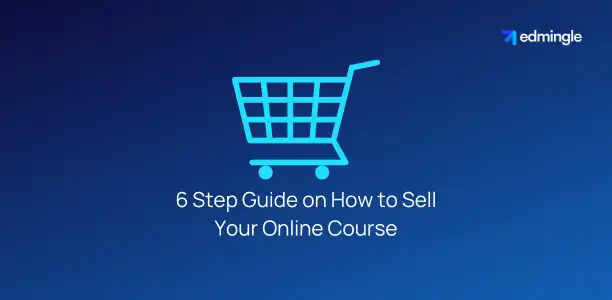
In this section, we describe the 6 simple steps to sell your newly created online course. By following these steps, you’ll effectively monetize your curriculum.
Step 1.Choose Your Business Model
Amidst many, the 4 major models include:
- Online courses: Offer standalone courses for learners seeking specific skills or knowledge.
- Cohort-based courses: Facilitate group learning experiences with a set start and end dates.
- Memberships: Provide ongoing content and online community for your subscribers.
- Pricing: Determine the value of your course. And set a pricing strategy so that learners can enrol by paying via debit/credit cards.
Step 2.Compel Your Target Audience to Convert
Design a persuasive landing page. One that highlights all the benefits of your course. It should also highlight the end goal. And hence, encourage enrollment while building your online presence.
Step 3.Guide Your Prospects through a Sales Funnel
Develop a step-by-step sales funnel. Craft it to guide potential customers from awareness stage to enrollment.
Step 4.Market to Your Audience
- Mini courses: Offer these for free to showcase your expertise and attract learners.
- Viral giveaways: Create buzz and expand your reach through exciting giveaways.
- E-books: Share valuable insights through free downloadable e-books.
Step 5.Gather Feedback & Refine Your Course
Collect feedback from learners. And then make improvements to enhance the overall experience.
Step 6.Foster a Learning Community
Create opportunities for learners to interact, collaborate, and learn from each other. Build a supportive online community of learners.
With this 6 step-by-step guide, you’ll be well on your way to make a real impact. While fulfilling your educational and entrepreneurial aspirations.
You might also like to read our article on: {15 Reasons} Why You Must Use an LMS for Selling Your Courses.
6 Important Questions to Consider for Creating a Successful Online Course
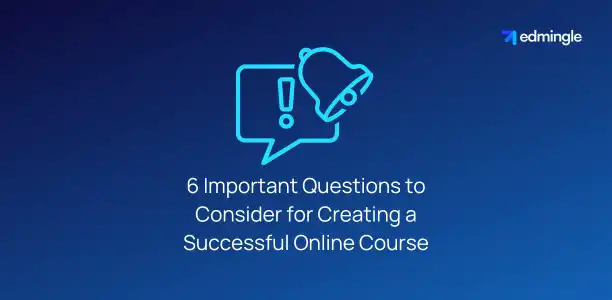
But wait just a little before you dive into creating one. Let’s ensure you set sail in the right direction from the beginning.
Here are the 6 questions you need to answer first.
- What people are searching about your chosen topic?
- Make use of the power of search engines. Step into the shoes of your potential students. Look into the search volume of keywords related to your expertise. Find out what questions are they asking about your chosen topic.
- Tapping into these queries will not only help you address their specific needs. But also demonstrate that its is tailored to them.
- Is your chosen topic garnering search interest & queries?
- A quick look at online searches can reveal the demand for your topic. Are people actively looking for information related to it? If yes, ensure that your curriculum aligns with these inquiries. This enhances its relevance and visibility.
- Is there a void in content from competitors?
- Is there something lacking in what your competitors are offering? Identifying these voids provides you with an opportunity to create content. That addresses unmet needs. Thereby, setting yours apart from the rest.
- How can you set your course content apart from the rest?
- With countless options available, what makes yours unique? Craft a distinctive selling proposition (USP) that sets you apart. Whether it’s your teaching style, real-world examples, or interactive elements. Your USP draws learners to you.
- How to Manage Finances & Attract a Fresh Audience?
- While aiming for high-quality materials. Keep an eye on your budget. Cost-effective solutions can be just as impactful. Additionally, consider attracting a “new” wider audience. Those who might be curious about your topic but aren’t experts. Catering to beginners widens your reach.
- If you’re considering hosting on an LMS. Read about learning management system pricing.
- Also, if you’re worried about operational costs. Check out how Edmingle reduces your operational cost by 20%.
- How to develop individual lesson plans?
- Creating a cohesive learning journey involves meticulous planning. Break down your curriculum into individual lessons that build upon one another. Ensure a logical flow, gradual complexity, and engaging activities. This keep learners hooked from start to finish.
As you embark on your online course creation adventure. Remember that its success is linked to how well you understand your audience.
Differentiate your content & create a learning experience that leaves a lasting impact.
5 Common Mistakes Online Course Creators Make
The world of online education is booming, and it’s easy to see why. But if you’re considering creating one, be wary of the pitfalls.
Even with the best intentions. It’s common to make mistakes that could hinder your success.
Here are the 5 common blunders to avoid while creating an online course.
| 1.Creating Lengthy Videos/Lessons While it might seem like a good idea to pack all the information into a few video lessons. Lengthy lessons can deter your batch of students. Long videos can become tedious and lose the attention of learners. Bite-sized is Right-sized: Short, concise lessons are more digestible. It allows students to grasp concepts quickly and keeps them engaged. Divide and Rule: Break down complex topics into several shorter videos. This also gives students a sense of accomplishment as they complete each section. Read about microlearning here. |
| 2.Worrying About Perfection Creating an online course is a big endeavor. And it’s natural to want everything to be perfect. However, striving for perfection can lead to procrastination. Done is Better than Perfect: Remember, you can always update based on feedback. Start with a minimum viable product (MVP) and refine over time. Iterative Creation Process: The beauty of online content is they can be updated. So, first launch and then polish. |
| 3.Forgetting to Test Now that you’ve put in the hard work. And it looks great! Don’t forget to test before you launch it. Check for Bugs: Whether it’s a video not playing, a link that’s broken or a quiz that doesn’t record scores. These can ruin the user experience. Gather Feedback: Before going public, get a few people to try it first. Their feedback can provide invaluable insights. |
| 4.Failing to Leverage Marketing No matter how brilliant your it is. If no one knows about it, they can’t enroll. Build Anticipation: Before launching, create a buzz. Use social media teasers, your email lists, or even blog posts. Email marketing campaigns are highly effective for this purpose. Use Testimonials: If you have testers or early users who loved your course. Get their testimonials. In the real world, real reviews/social proof builds trust. |
| 5.Engaging in Underpricing Pricing can be tricky. While you don’t want to scare potential customers away with high cost. Undervaluing your course isn’t the solution either. Value Proposition: Price it based on the value it provides. If it’s comprehensive & offers unique insights. Don’t be afraid to charge a premium fee. Research: Look at similar options in the target market. This can give you a baseline for your pricing strategy. |
Creating an online course can be a fulfilling endeavor, both intellectually and financially. And by steering clear of these common mistakes, you’re setting yourself up for success.
11 Best Platforms to Create and Sell Your Online Course in 2024
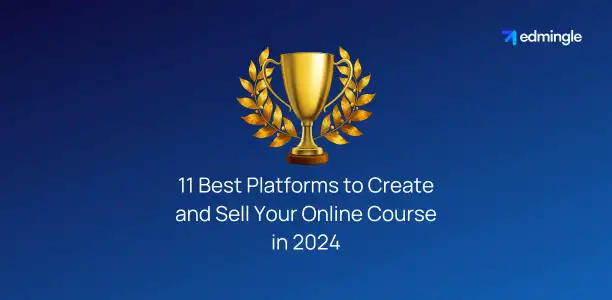
The online education market is booming. And choosing the right platform to create and sell your online course is crucial.
Here’s a look at the 11 best platforms in 2024. Each with its unique features & strengths.
1.Edmingle
Edmingle is a SaaS LMS platform that stands out for its user-friendly interface and comprehensive feature set. It’s particularly great for training businesses. The platform offers robust integrations & delivers a seamless learning experience.
With it’s exceptional customer support & service, it stands unmatched in the LMS landscape. Furthermore, it’s trusted by 5000+ training businesses across 160+ countries. This includes McGraw Hill, Aditya Birla Education Academy, MIT SDE & many more.
2.Teachable
Teachable is renowned for its intuitive course builder and powerful sales & marketing tools. It also offers great analytics to track student engagement and course performance.
3.Podia
Podia is an all-in-one platform. It not only lets you create and sell courses. But also offers the ability to sell digital downloads and memberships.
4.Thinkific
Thinkific is praised for its balance of simplicity and powerful features. It offers a range of customizable & supports various multimedia formats.
5.LearnWorlds
LearnWorlds is a feature-rich platform that excels in providing interactive learning experiences. It stands out with its ability to create interactive videos, quizzes & certificate.
Skillshare operates on a membership model. This platform is excellent for creators who want to tap into an existing community of eager learners.
7.Kajabi
Kajabi is more than just a course platform. It’s a full-fledged business platform. It offers advanced marketing tools, including email marketing & sales funnels.
8.Udemy
Udemy is one of the largest and most well-known online learning platforms. With a massive audience, it’s a great place to reach a diverse range of students.
9.LearnDash
LearnDash is a WordPress plugin. And is perfect for those who already have a website on this platform and want to integrate an LMS.
10.Coursera
Coursera partners with universities and organizations to offer a wide range of courses. Hence making it ideal for academically inclined course creators.
11.Academy Of Mine
Academy Of Mine is a high-end platform offering extensive customization and integration capabilities. It’s tailored for professional training providers and businesses.
Each of these platforms offers unique features to suit different needs and goals. And selecting the right platform can make a significant difference in your online course’s success in 2024.
Conclusion
Wrapping up, if you’re an expert eager to share your knowledge with the world. Creating an online course is an excellent avenue.
And this blog on how to create an online course eases the journey of creating and selling one.
Each step mentioned in this article is a critical piece of the puzzle. So, if you’re ready to take that leap and transform your expertise into a thriving online course business.
Remember that every great journey begins with a single step.
FAQs around How to Create an Online Course
1.How much time is needed to create an online course?
The time can vary from a few weeks to several months. Depending on the depth, complexity & production quality of the course.
2.What is the expense involved in creating an online course?
Costs can range from minimal if you’re doing everything yourself. To several thousand dollars if you’re hiring professionals. Mainly for content creation, videography, digital marketing and email campaigns.
3.How to make an online course more engaging for learners?
Incorporate quizzes, assignments, forum discussions & multimedia elements like videos and infographics.
4.Is creating an online course challenging?
While there’s a learning curve. With the right resources, tools & guidance, anyone can create an effective online course.
5.What types of online course creation software are required to craft an online course?
Basic tools include an online course creation software (e.g., PowerPoint) and video recording/editing tools. Furthermore, a website, LMS platform or an online course marketplaces will be helpful.
6.How should I organize the learning material for my online course?
Start with an introduction. Followed by main content modules & conclude with a summary. Ensure a logical flow throughout.

Comments (3)
52 Learning Management System Features | Comprehensive Guidesays:
September 4, 2023 at 7:12 am[…] You might also like to read our blog on: 12-Step Guide on How to Create an Online Course. […]
19 Top White Label LMS Platforms : Complete Branding Masterysays:
September 5, 2023 at 11:59 am[…] To enhance the learning experience furthermore, you can start by creating the perfect course following these 12 steps. […]
Hybrid Learning Management System: A Complete Guidesays:
September 15, 2023 at 5:34 am[…] At its core, a Hybrid LMS is an integrated educational approach that blends the tried-and-true methods of conventional classroom teaching with the expansive capabilities of online learning. Think of it as having the best of both worlds – the personal touch and real-time interactions of face-to-face lessons combined with the accessibility and adaptability of online courses. […]